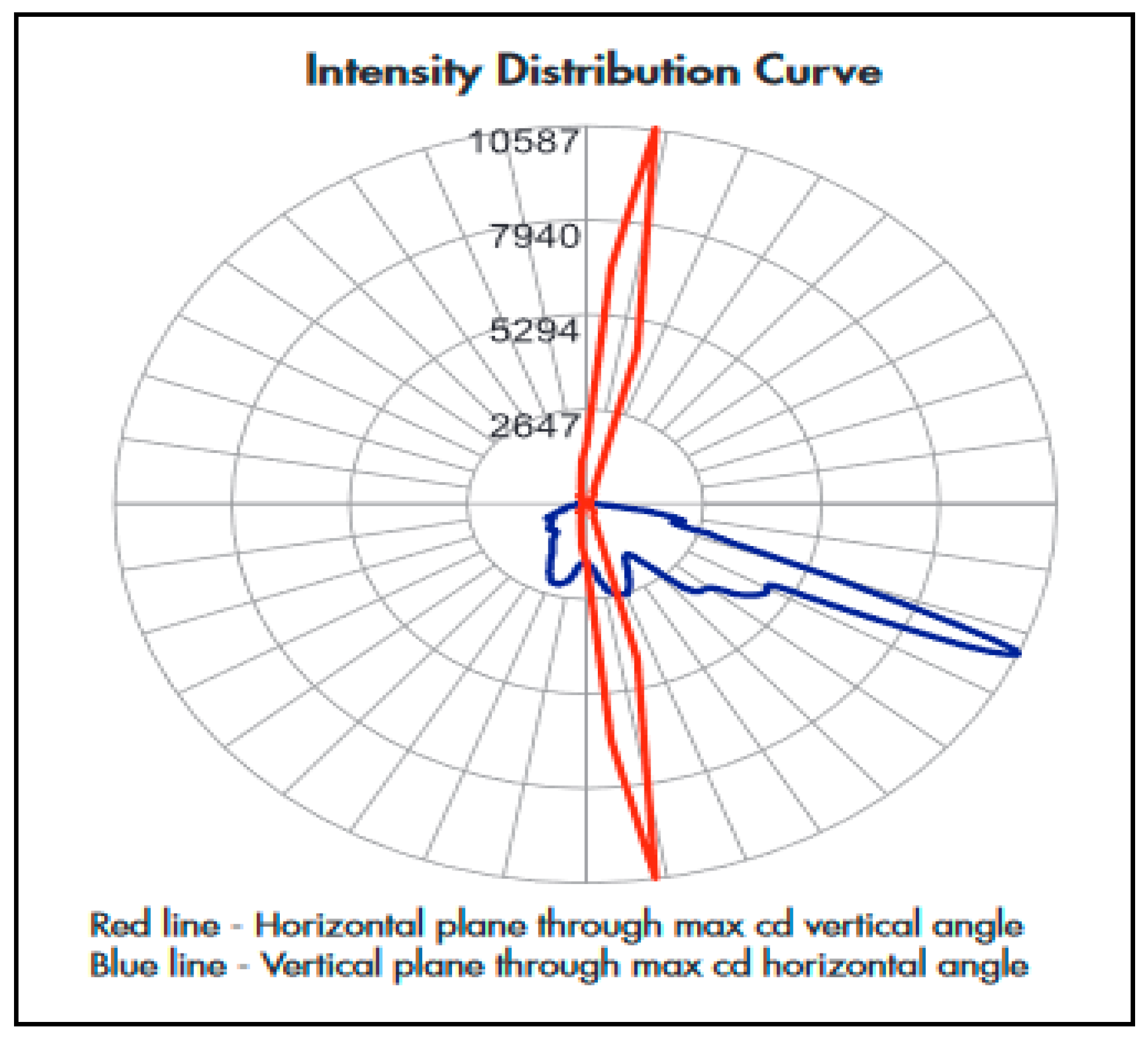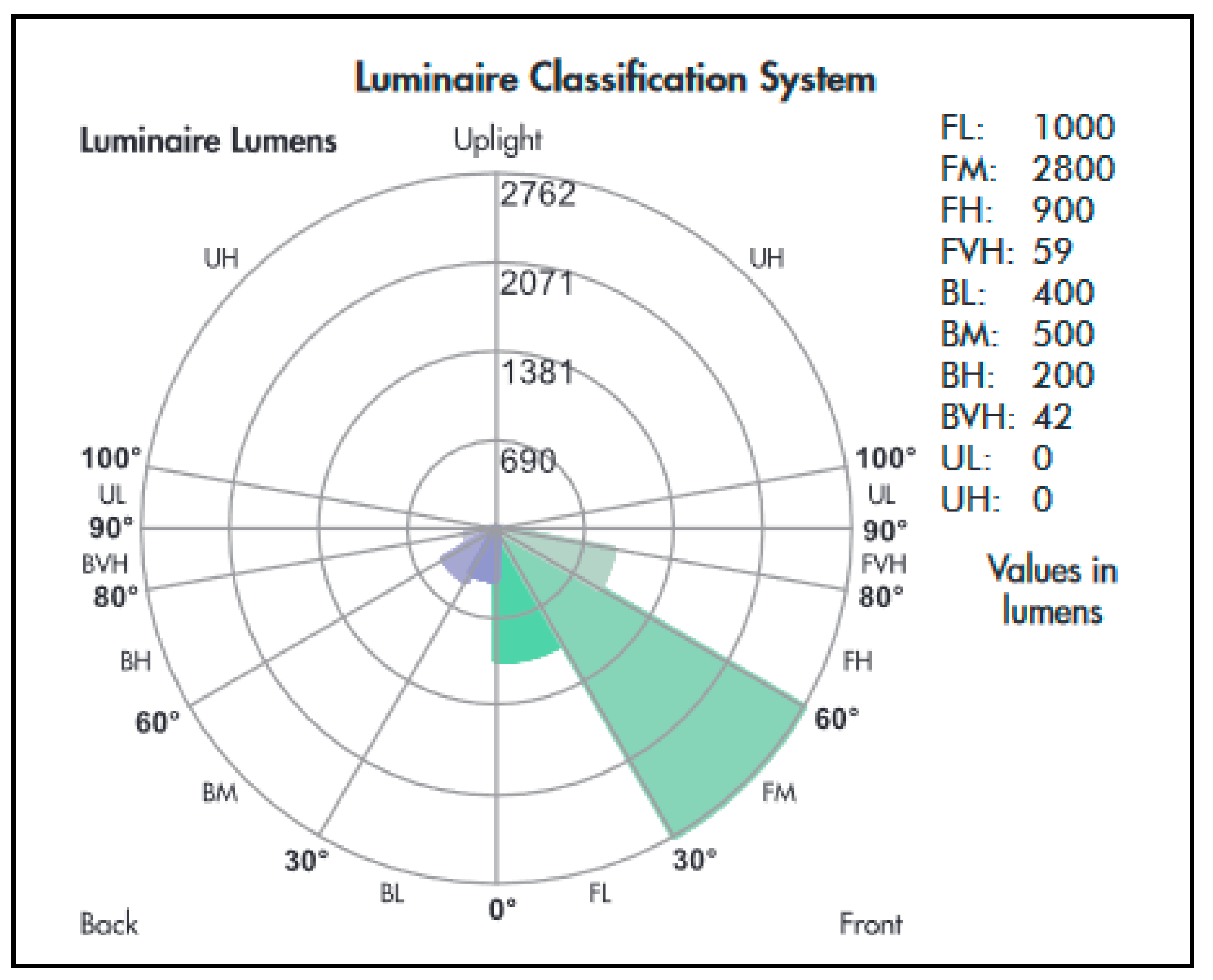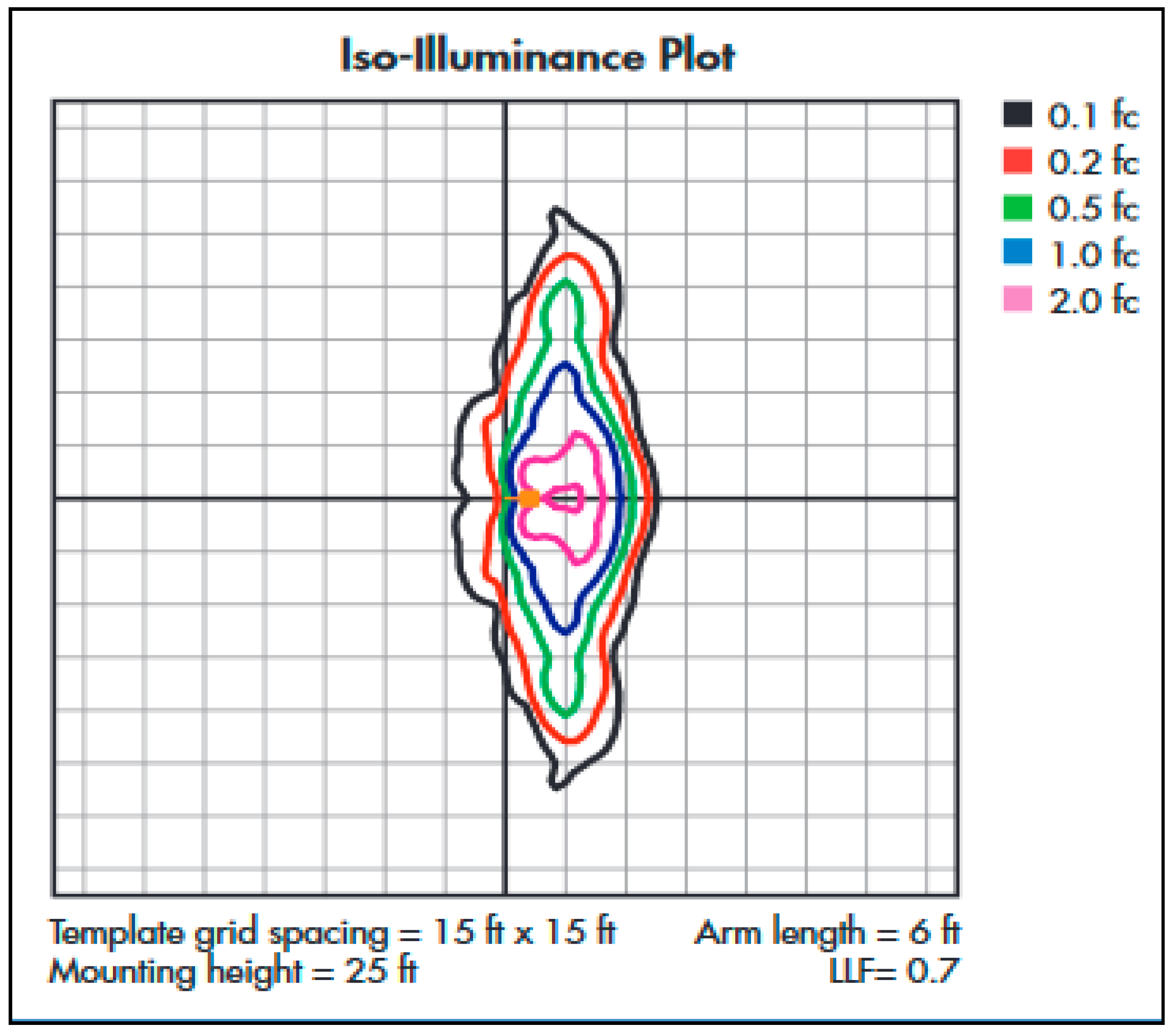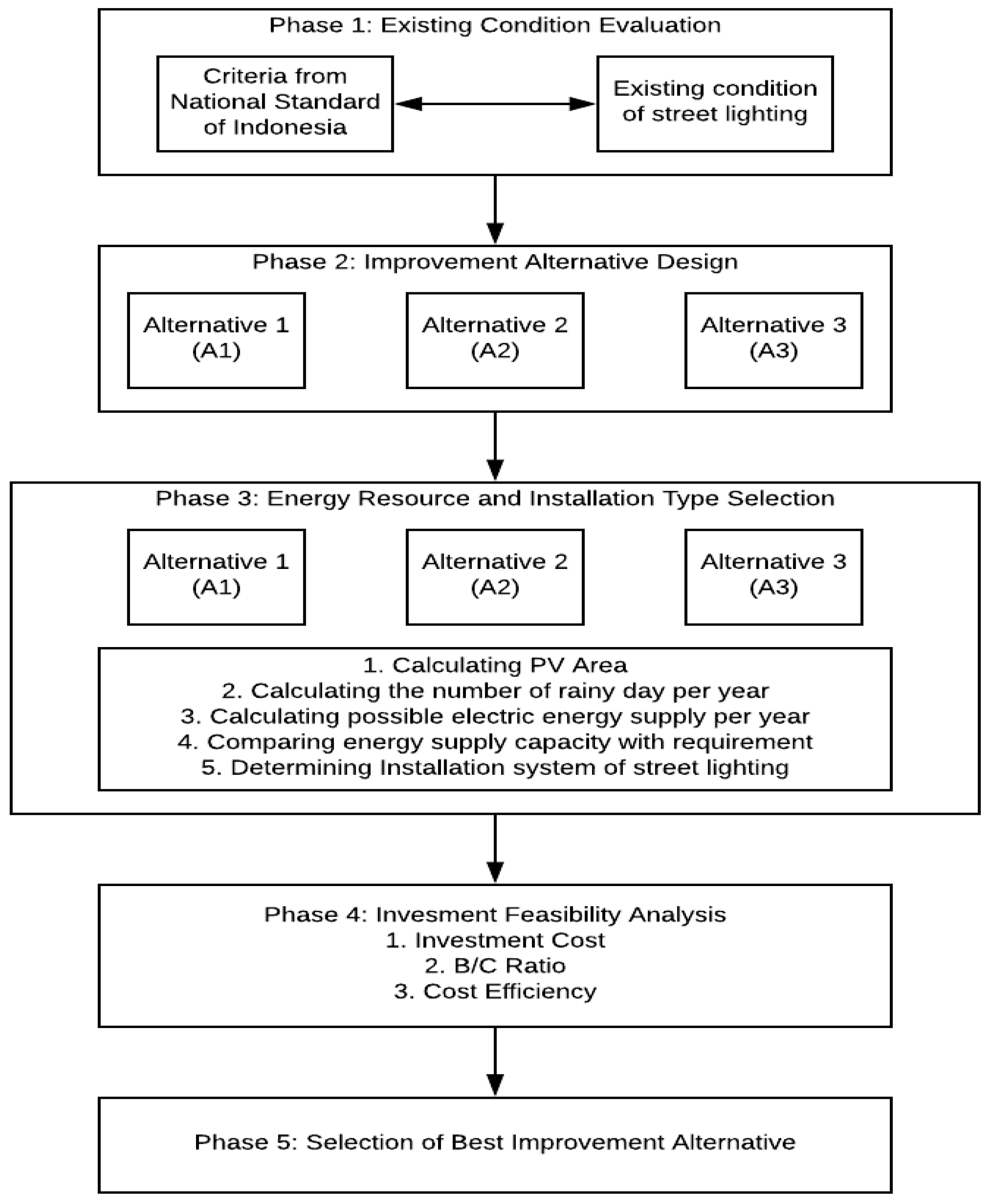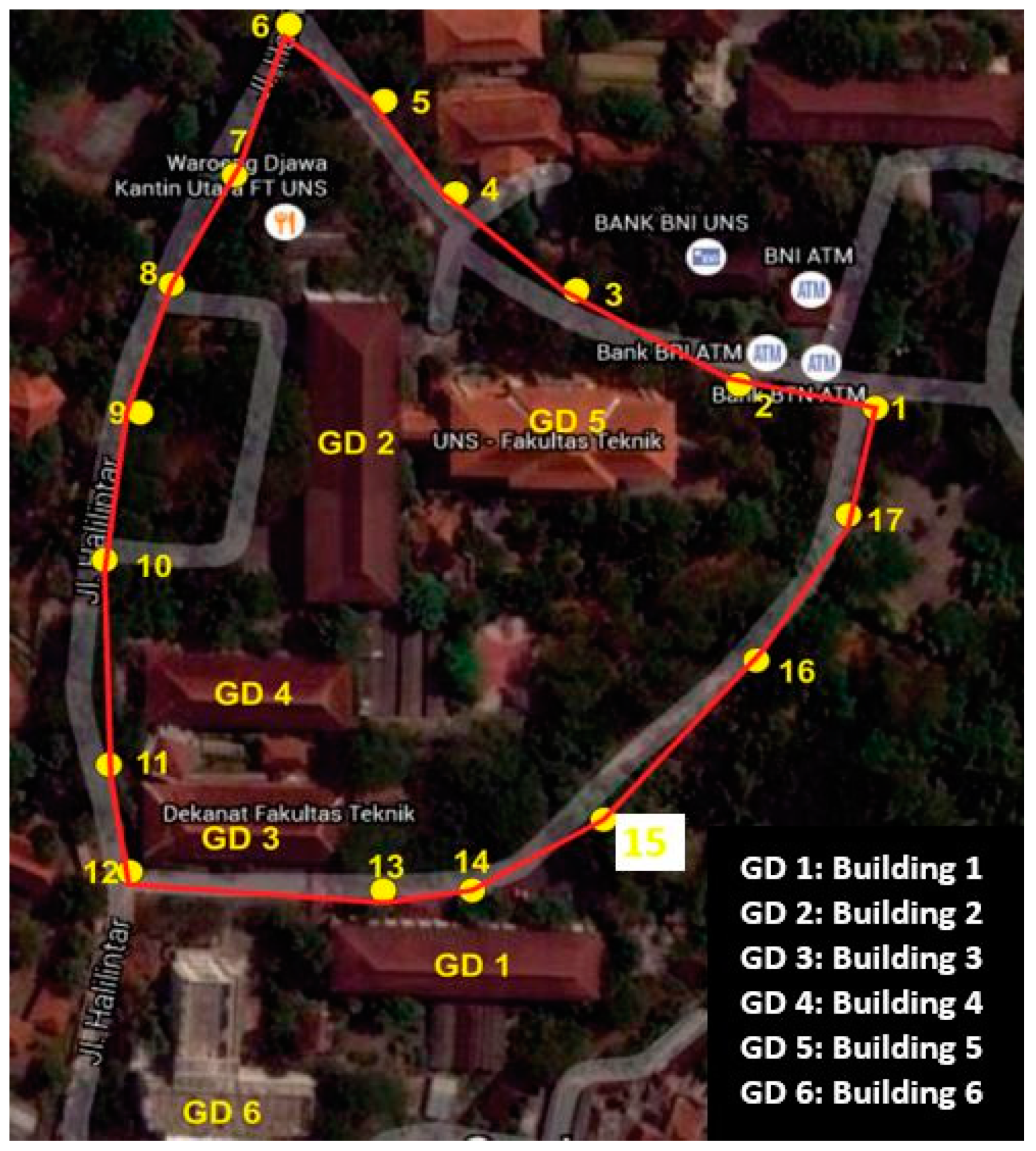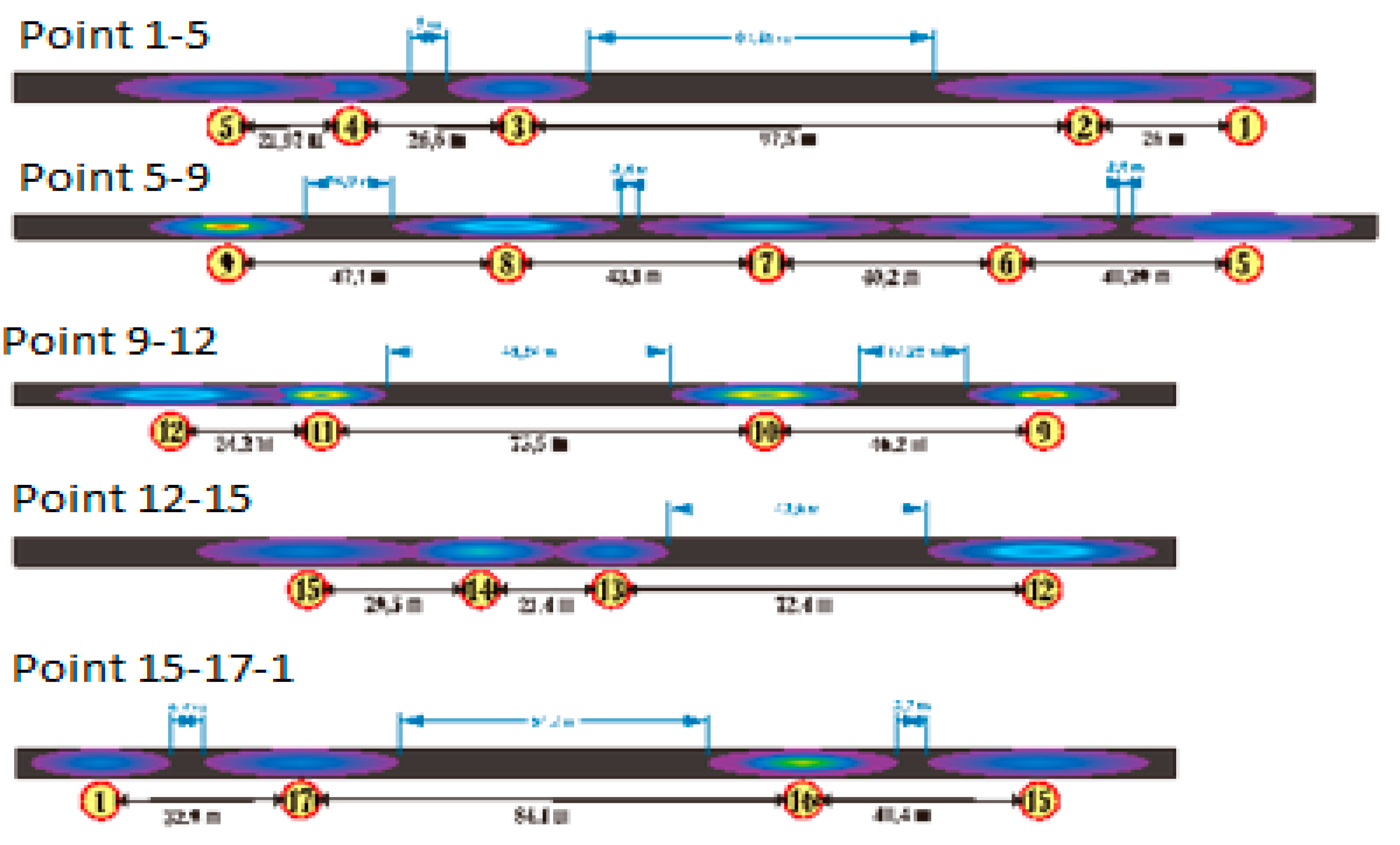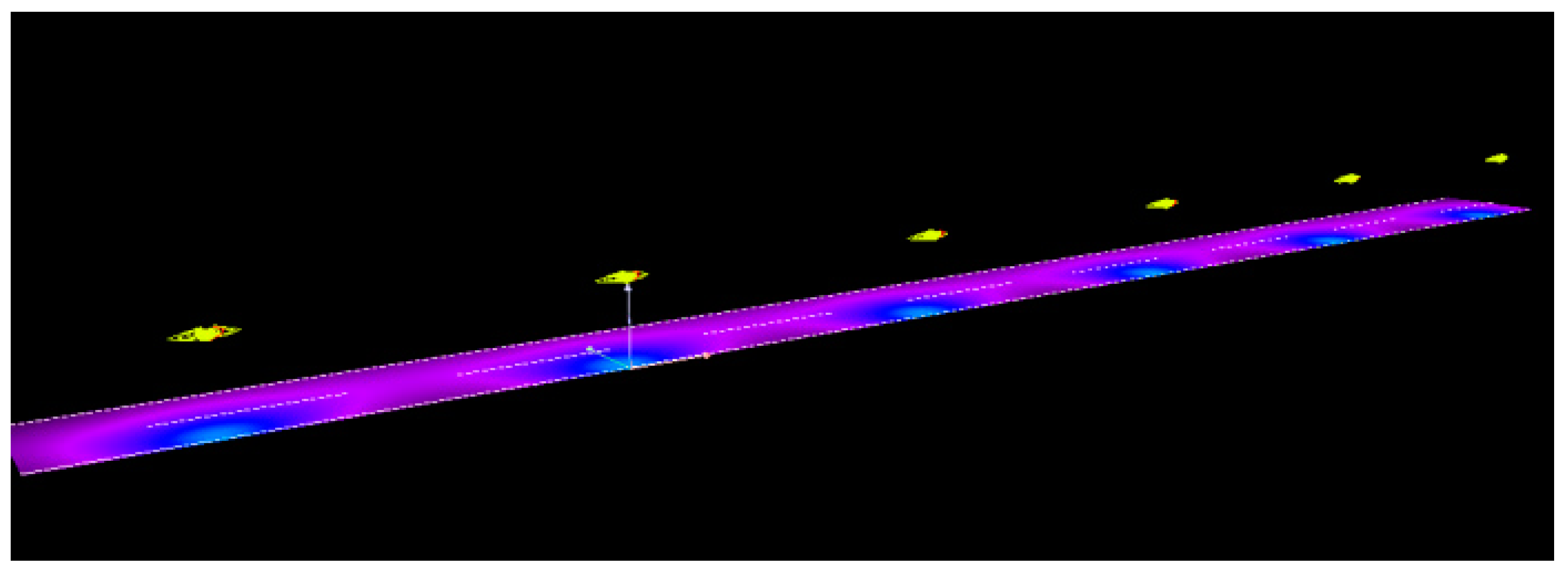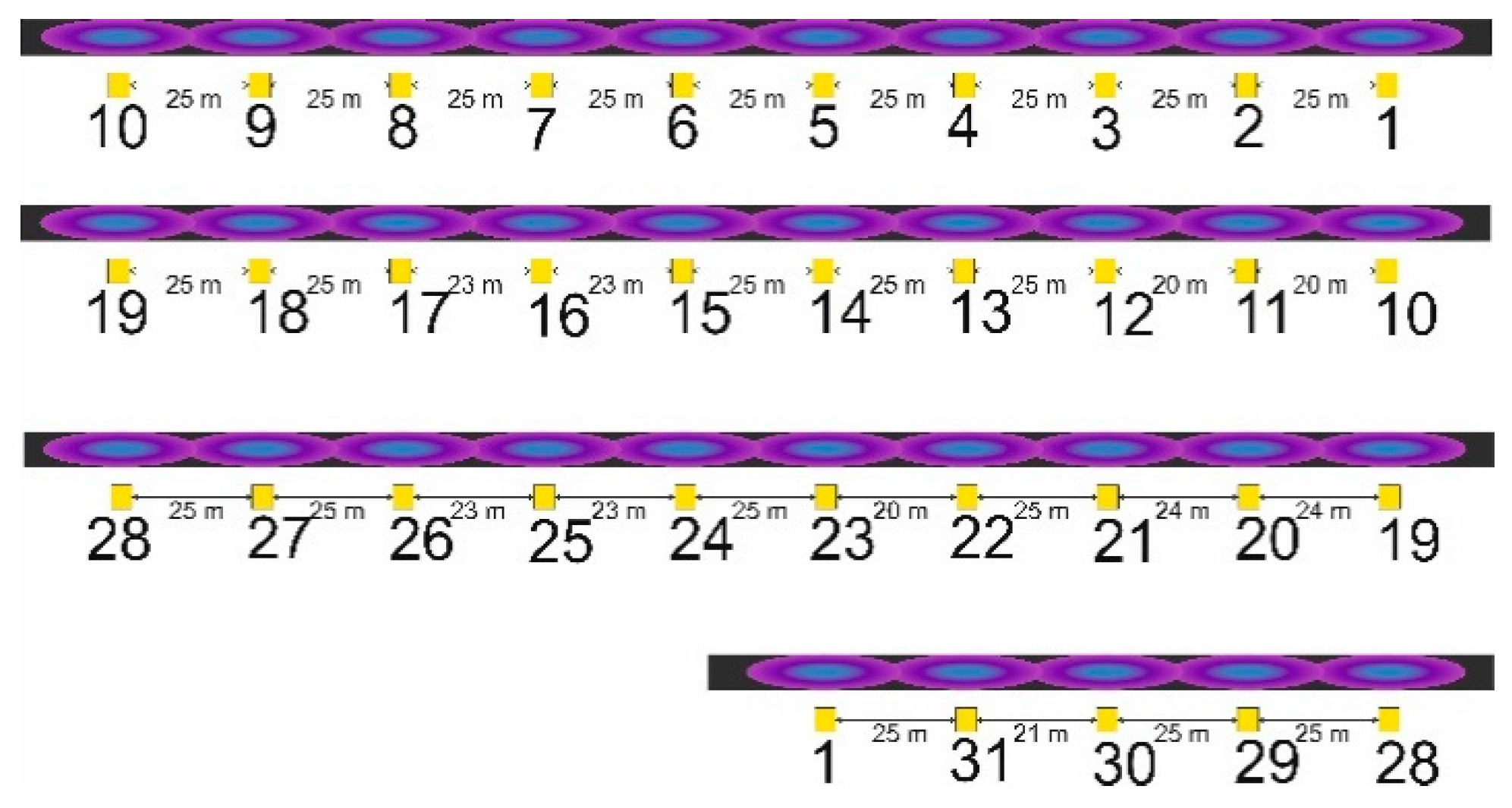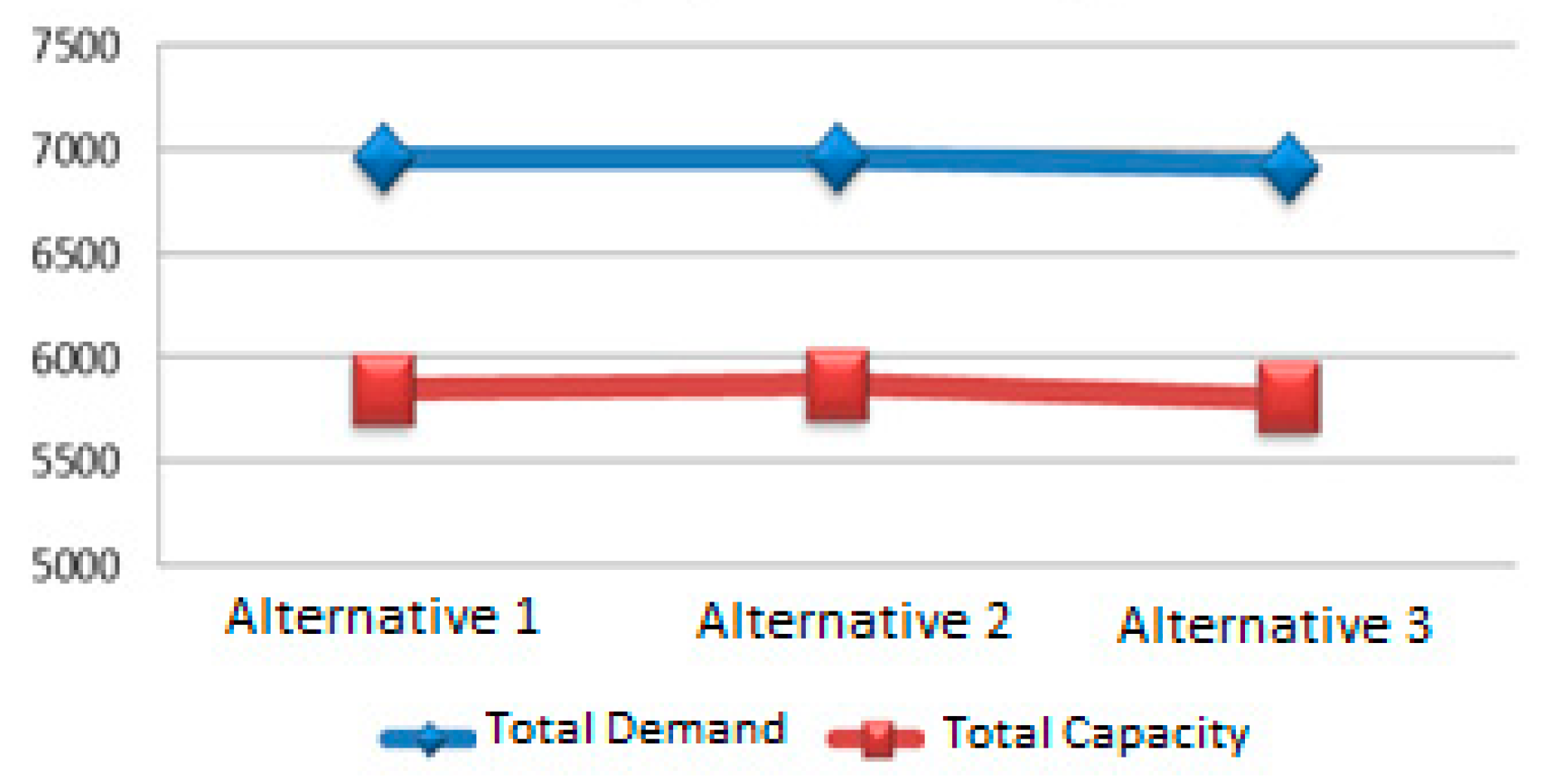1. Introduction
Batteries are classified as primary and secondary batteries [
1]. A primary lithium battery is an un-rechargeable battery with lithium metal elements as the anode. The primary cell is commonly used in watches, calculators, and other electronic devices. A secondary lithium battery is a rechargeable battery that is usually found in consumer electronic products such as notebooks, personal computers, smartphones, electric bikes, street lighting, and many other electronic gadgets [
2].
Street lighting is an essential part of most facilities. However, high operating costs, improper illumination levels, and inefficient power are usually experienced with respect to street lighting installation systems. The lighting quality of a particular street is influenced by several factors such as street type, street width, pole height, the distance between poles, and the type of lamp being used according to the National Standard of Indonesia (NSI) (NSI 7931:2008) [
3]. The quality is indicated by the illumination level in certain areas [
3].
There are papers about the study of the techno-economy of public street lightings by various authors, such as Velaga and Kumar [
4], Kusumayogo et al. [
5], Sihombing and Kasim [
6], and Jamil et al. [
7]. Ahmad [
8] and Al-Salaymeh et al. [
9] studied the technical and economic assessment of photovoltaic in residential buildings. Ramadhan and Naseeb [
10] studied the cost–benefit analysis of implementing a photovoltaic solar system. Kannan et al. [
11] presented a life cycle assessment study of a solar photovoltaic system. Reid and Wynn [
12] studied the future of solar power in the United Kingdom and calculated its economic impacts. Escolar et al. [
13] sought to improve the quality of street lighting in Spain. Cellucci et al. [
14] studied smart lighting in a small town. Salata et al. [
15] made an economic and investment assessment of safety and emergency lighting in road tunnels. However, previous methods have not been able to perform a real case study analysis of the techno-economic feasibility of solar energy while considering the NSI [
3] regarding street lighting specifications in urban areas.
The Faculty of Engineering in Universitas Sebelas Maret is a campus area that has a public institution that provides street lighting facilities. A case study in this research was held on this campus. There are 17 lighting points spread on the street surrounding the faculty. Evaluation of the provided facility shows that 64.7% is black area. In other words, the system does not suit the national standard. In light of this issue, a new installation of lighting needs to be designed.
NSI 7391:2008 regarding “Street Lighting Specification in Urban Area” was used as the standard reference in the design process of the new lighting system. Several aspects to be considered in the design process were lighting quality, used material, energy source, and the installation type. DIALux 4.12 is software that can assist in the process, especially in lighting quality improvement. DIALux 4.12 can simulate natural and artificial light and can update continuously. DIALux 4.12 also offers a balanced combination of technical analysis and graphical results that make it appropriate [
16,
17]. This software can be applied not only to street lighting but also to long road tunnel lighting simulation [
18].
As Indonesia has massive potential in solar energy [
19,
20], alternative energy resources can be exploited. An example of solar energy utilization is solar-energy-based street lighting. Universitas Maret University, a “green campus,” has begun to develop new street lighting technology with more environment-friendly energy—solar energy. Besides a technical assessment, examining the implementation of the latest technology requires investment feasibility analysis. The full review can be summarized in two stages of evaluation, the technical aspect and the economic aspect, and the efficiency level can also be compared to conventional electric resources.
2. Materials and Methods
Street lighting is part of a complementary structure of roads that can be placed or installed on the left or right side of the road and/or in the middle (in the middle part of the road) and is intended to brighten the path or neighborhood around the required road, including crossroads, bridges, and underground roads [
21]. The components of a complete street lighting construction consist of a light source, an optical element, an electrical element, a support structure, and a light pole foundation [
22].
Street lighting in this area is spread throughout the campus area. The lighting of public roads in the campus environment is divided into two types, namely, main public road lighting and solar-based street lighting support. The difference between these two types of illumination lies in the function and the type of lamp used. The main street lighting serves as the lighting on the main road of the campus, while the solar-based street lighting support serves as street lighting and illuminates locations or buildings in the campus environment.
In this study, the number of main street lighting points was 74 units. Public road lighting that exists on-campus still entirely employs electrical energy, sourced from the State Electricity Company Indonesia (PLN, Perusahaan Listrik Negara). This makes it suitable as a case study in investigating the application of solar-powered public lighting.
Street lighting with solar energy as the source of energy is an energy-saving alternative [
23]. As the energy comes from the sun, the operational cost of the street lighting is cheap and economical [
24]. Solar street light lighting uses solar cell panels that receive sunlight and convert it into energy through a photovoltaic process [
25]. The illuminations can work automatically, with lights that go on at night and go out in the morning, with easy and inexpensive maintenance. The street lighting of the solar powerhouse itself consists of several components, namely solar cell panels, LED lights, lamp posts, and battery boxes [
26].
The source of solar street light energy comes from the light of the sun, which is then absorbed by the solar cell panel. According to Markvart et al. [
27], the process of solar cell panels starts by converting the sunlight into a DC current, which is then stored inside the battery. Before being stored in the battery, there is a device that acts as an energy flow controller, and this tool regulates a system that works on a common solar street lighting called a controller. The controller is given times when the lights must be on and when the lights must be off; there is also a system that regulates when the battery should be charged. Next, to set the battery management system, there is a tool called a battery management system (BMS) that serves to cut off and discharge the battery [
28].
The lifetime of the solar cell panel is 25 years old [
29,
30]. For an LED lamp with 50,000 h of life, if the lights are on for 12 h every day, then the lamp can operate for 11 years [
31,
32], and this lifetime can be compared with conventional solar-based street lighting, which the State Electricity Company still employs. So far, solar street lighting has proven advantages over conventional street lighting [
33], but the application of solar-powered public road lighting is restricted by weather constraints and high investment costs. Therefore, in this research, the utilization of solar-based public lighting will be analyzed in depth, particularly on the feasibility of the investment to overcome these problems.
2.1. The Standard Components of Solar-Based Street Lighting
Several components in solar-based street lighting are used in the planning and designing of the primary construction of solar public road lighting. These elements include solar cell panels, lamps, LED lights, street lighting poles, and battery panel boxes.
Solar Cell Panels
The solar cell panel is an electronic component that can convert solar energy into electrical energy in the form of a direct current (DC). One part generates solar power, i.e., a solar cell that is about 10–15 cm squared. This component converts energy from sunlight into electrical energy [
34]. The solar cell is a vital component that is generally made of semi-conductor material [
35]. Electric power generated by a solar cell is so small that several solar cells must be combined to form a unit of the component, and this unit is called a module.
According to Sihombing and Kasim [
6], the operation of the solar cell maximum depends on the following:
ambient air temperature
solar radiation (insolation)
wind speed
Earth’s atmosphere
panel orientation or PV array
the position of the solar cell (array) with respect to the angle of orientation of the sun (tilt angle)
Lamps
Lamps are part of solar-based street lighting and serve as the lighting output. The application of the lamp type varies depending on the needs of the user. Each lamp has a light pollution based on their type [
36,
37,
38]. These types are as follows:
Sodium Lamps
Sodium lamps have an efficacy of 50–90 lumens/watt with a warm color temperature. This type has a lamp life of 24,000 h. It contains 1–6 mg of sodium and 20 mg of mercury when operating sodium at high temperature and pressure, which can make this lamp reactive [
39]. This lamp is out of date and no longer recommended for street lighting.
Mercury Lights
Mercury vapor lamps have a low efficacy of 30–65 lumens/watt, and this characteristic causes the lamp to emit a pale green light. These lamps are widely used as garden or street lighting lamps because of their high life span that can reach 16,000 to 24,000 h [
40]. Like sodium lamps, mercury lamps are out of date and no longer recommended for street lighting.
LED Lights
LEDs—light emitting diodes—are electronic components made of a semi-conductor type diode material that produces light. The light present in an LED lamp is electromagnetic energy emitted in the visible part of the spectrum [
41].
The intensity distribution curve, the luminaire classification system, and an iso-illuminate plot for LED 120 V is shown in
Figure 1,
Figure 2 and
Figure 3 below [
42].
2.2. The Planning and Design of Solar Street Lighting
Standards must be followed to construct solar-based street lighting. The standard is intended to ensure safe and optimal performance. In Indonesia, the predefined standards related to public road lighting are described by the NSI (NSI 7391:2008) [
3]. The standard components of public street lighting can be seen in
Table 1 below.
In designing solar-based street lighting, the energy requirement, the photovoltaic area coverage, and the operational cost need to be assessed. This serves to determine the amount of energy and specification that must be delivered; thus, it can provide the components required to be employed. In addition, the costs of installation, operation, and maintenance need to be calculated. Thus, the level of the financial feasibility of the application of solar street lighting can be measured.
Total Lamp Power
Total lamp power can be formulated as follows:
where
Lamp Power Every Month
The power of each month can be formulated by
where
Energy Cost
The energy usage cost incurred each month can be formulated as follows [
5]:
where
M = monthly usage fee (IDR/month);
U = rate of usage fee per month (IDR/kWh);
P month = the total power of the lamp each month (W).
PV Area Calculation
Power (watt peak), which can be generated by a solar-based street lighting system in generating electrical energy, can be calculated by the equation refer to reference [
49] below,
EL = energy consumption (kWh/day);
Gav = insolation of solar daily light (kWh/m2);
Ƞpv = solar panel efficiency (%);
Ƞout = overall system efficiency of the solar panel (battery and inverter);
PV area = solar panel area (m2).
From the calculation of the
PV area above, then the power raised by solar-based street lighting (watt peak) can be calculated by the formula below [
44]:
where
Furthermore, to obtain the number of solar panels required can be calculated by the following formula:
where
2.3. Investment Requirement for Solar-Based Street Lighting
The construction of solar-based street lighting will require a thorough estimation of investment. Investment in a project generally requires substantial funds and will affect investors in the long run [
50]. Therefore, meticulous investment planning is required to avoid unprofitable investing projects [
51]. Overall, the scope of aspects reviewed in a feasibility study include the following:
Technical aspects
A technical aspect is reviewed to determine the feasibility level of the project from a technical point of view. Evaluation of technical aspects includes product description, determination of the economic production capacity of the project, production processes undertaken, the raw material inventory, the amount of labor, the use of machinery, and equipment. This review is an attempt to answer whether the project is reliable, safe, and accountable [
52].
Financial aspects
The financial aspect is an analysis from the point of view of the project or financial manager. In this case, the analysis of the financial aspects is related to solar-based street lighting components that require funding and to estimated revenue/earnings. It is examined especially by a comparison between money spent and the revenue/earnings of the project [
53]. The purpose of financial analysis is to determine whether a project is financially viable, i.e., whether the project is capable of producing a proper return on invested capital.
The method used to measure investment feasibility in this research is benefit–cost analysis. Benefit–cost analysis is a common analytic method to evaluate government or company projects. This analysis is a practical way of estimating project benefits, for which a review is necessarily long and wide [
54]. In other words, analysis and evaluation of various audits require a relevant view of the costs and benefits that are involved [
55]. The cost–benefit analysis looks at the ratio between the benefits of a project to the general public against the costs incurred by government. Mathematically, it can be explained using the formula below:
where
BC Ratio is the benefit–cost ratio (
BCR), equivalent benefits are all benefits that have been reduced by negative impacts, expressed as a monetary value, and equivalent expenditures are all costs after deducting the magnitude savings that can be obtained by a project sponsor, in this case, the government.
The costs to be borne by a project are actually composed of the cost of investment and the operating and maintenance costs. In the analysis, the cost and benefits of operating expenses are included as negative benefits [
56]; thus, the above formula can be modified as follows:
From the above equation, the feasibility of an investment from a business can be determined. If the value of BCR => 1, then running the project is feasible. If BCR < 1, then it is not feasible. If all > 1, then one should seek the largest BCR value. If all < 1, then one should seek the smallest BCR value.
To assess the feasibility of solar-energy-based street lighting, it is necessary to employ certain methods to obtain accurate analysis results; thus, such methods can be applied as a reference for investment. In order to facilitate this analysis, the research methods have been divided into several stages to provide a progressive analysis related to the deployment of street lighting in this case study. The methodology of the case study in this research can be seen in
Figure 4 below.
Based on
Figure 4, the analysis method in this article consists of five phases.
Phase 1: Existing Condition Evaluation
This evaluation is conducted in order to assess the utility, performance, and judgments related to the quality of a particular case [
57,
58]. In this research, the street lighting is evaluated by examining the existing condition of the lighting system on the street around the faculty by comparing them with the NSI criteria. The comparison itself is made to explore performance and quality, i.e., whether the current existing light is better or lesser than the NSI. Moreover, the evaluation is assessed using DIALux 4.12 software.
Phase 2: Improvement of Alternative Design
The evaluation process in Phase 1 results from three alternative designs. The first alternative (A1) replaces all present lighting systems. The second alternative (A2) proposes the repair of pole height and/or lamp power or the installation of new lighting poles. Grouping street lighting based on pole height is the third alternative (A3). The three options are simulated by DIALux 4.12 to check whether the new lighting system is compatible, and a minimum percentage of black area is determined.
Phase 3: Energy Resource and Installation Type Selection
Next, the energy resource of the lighting is determined by a set of calculations, involving PV area, annual rainy day, energy supply capacity, and energy requirement per year. The resource can be fully conventional energy, fully solar energy (off-grid), or a combination of solar and conventional energy (on-grid). Next, the system installation type is chosen, i.e., stand-alone or centralized. The energy resource and installation type are determined for all respective alternatives.
Phase 4: Investment Feasibility Analysis
Besides technical assessment, investment feasibility analysis needs to be conducted in order to determine whether the proposed improvement is economically feasible and competitive [
59,
60,
61]. The benefit–cost ratio (
BC Ratio;
BCR) is used to examine the economic feasibility of the system. More than one alternative might be considered technically and economically feasible, but only one is chosen.
Phase 5: Best Improvement Alternative Selection
If analysis has been robustly conducted, considering technical and investment feasibility, the best alternative will be selected as the primary street lighting system.
3. Results
3.1. Evaluation of Existing Street Lighting System
The evaluation process began by assessing several aspects of 17 lighting points spread around the faculty (
Figure 5), including pole height, distance between poles, illumination level, and lamp power. All of the data were processed by DIALux 4.12 software to reveal light distribution. Light distribution is shown in
Figure 6.
The result was compared to the national standards of street lighting for an evaluation summary. According to the evaluation, the current condition results in 64.7% black area, which increases vulnerability to accidents and crime incidents. Hence, an improvement regarding street lighting design is required.
3.2. Design of New Street Lighting System Structure
We present three alternatives to the current street lighting system. The first alternative (A1) replaces all present lighting systems. The second alternative (A2) proposes the repair of pole height and lamp power or installing new lighting poles. Grouping street lighting based on pole height is the third alternative (A3). In the decision process, several factors need to be considered, such as pole height, distance between poles, street width, and lamp power and type. LED lamps are used in this system due to the lower amount of power consumed to emit the same amount of lumens as mercury lamps [
58]. These factors were processed in the lighting simulation software DIALux. The DIALux results show whether the alternatives are feasible or not.
According to the software, the A1 option provides three alternatives to the lamp structure regarding the power, pole height, and distance between poles. The best lamp structure is determined based on cost efficiency and illumination level assessment. LED lamps with 50 watts of power, a 6 m height, and a 25 m distance to the adjacent lamp pole are the best option. The A1 option is technically feasible because the simulation shows no black area on the analyzed streets. The simulation result of the A1 option can be seen in
Table 2 and
Figure 7.
The A2 option was simulated in another way. Calculating the distance between black areas is the first step, so as to improve either the lamp power or the pole’s height. A new lighting spot is added only if the two previous treatments are unsuccessful. The simulation result shows that the A2 option needs to replace two lamp spots, Points 3 and 4, with lamps with a higher power. As many as 14 lamps would be required. Thus, the lighting system in the A2 option is feasible because the black area is diminished.
Table 3 and
Figure 8 elaborate the simulation results of Alternative 2 in more detail.
Unlike A1 and A2, the A3 option groups lighting points based on the pole’s height. The simulation has three groups of poles. The first group is for lamps with taller than 6 m, 4–6 m lamp poles are classified into the second group; and the rest of the lamps are grouped in the last group. The black area found in areas with lamp poles with a height of less than 4 m vanishes when lighting points with lamp poles ≥ 4 m in height are added.
Meanwhile, the other black areas are lightened with 4–5 m lamp poles. Notwithstanding the non-standardized lamp height, poles are kept under the assumption that there are neither heavy vehicles nor buses passing. In addition, there is no black area in the DIALux simulation using the A3 system option, which means it is technically feasible for implementation. The simulation result of A3 is explained in
Table 4 and
Figure 9 more clearly.
3.3. Energy Resource and Installation Type
Three alternative energy sources are available in designing the new street lighting system: conventional, solar cells (off-grid), and a hybrid of solar and conventional energy (on-grid). In order to decide which source is the best choice for implementation, the PV area needs to be known, which is determined by the equation below [
49]. The PV area will provide information regarding the comparison between energy requirement and probable capacity, respectively, for each improvement alternative.
where
EL = energy consumption (kWh/day);
Gav = daily sunlight insolation (kWh/m2);
Ƞpv = solar panel efficiency (%);
Ƞout = total efficiency of the solar panel (battery and inverter);
PV Area = solar panel area (m2).
The first step in calculating the PV area is determining the total energy needs for daily street lighting operation. A1 and A2 each require 19.07 kWh; A3 requires 18.95 kWh for daily operation. However, the PV calculation loss factor value and the lamp operational duration need to be considered. The loss factor value is the amount of generated energy that is lost due to conversion from electric to heat energy (loss energy). The loss factor value here was 1.26 kWh, while the operation time was assumed to be 12 h.
G
av is the daily lighting insolation value, which is considered from 6:00 a.m. to 6:00 p.m. Lighting insolation is the radiation energy coming from the sun to the earth’s surface. Surakarta City gains 3.3 kWh/m
2/day of sun insolation [
45].
The other considered variables are
Ƞpv and
Ƞout, which stand for the solar cell panel efficiency, which is as high as 17% [
42], and the component efficiency, which both complement solar-panel-based street lighting systems. The system is equipped with a battery, an inverter, and a controller, which means
Ƞout is a multiplication value of those three components, as shown by the equation below. Calculation of
Ƞout is as follows:
battery inefficiency = 15%;
inverter inefficiency = 10%;
controller inefficiency = 2%.
The optimum temperature in solar panel cell work is 25 °C, yet geographical data from NASA shows that the average temperature of Surakarta City is 27.1 °C [
44]. This condition leads to a power reduction for every temperature rise. The temperature change factor (TCF) value can be calculated by the expression below.
If the value of
Gav,
Ƞpv,
TCF, and
Ƞout are distributed into the PV area function, the possible produced energy capacity can be found. The number of rainy days then needs to be determined. A rainy day calculation is required since Indonesia has two seasons—a rainy and a dry season—and it is feared that the rainy season is not able to support the system and produce sufficient energy. Rainy days in Surakarta are projected to be 63 days annually [
62]. A comparison between energy requirements and the capacity in a year can thus be determined.
Based on the calculation result, it can be seen in
Figure 10 that the energy produced by solar cells cannot satisfy the energy requirement of the new street lighting system. Hence, a grid system is considered most suitable for the implementation of the new street lighting system. A hybrid of solar cells as main energy generators and conventional energy sources can maintain the street lighting system well operated when there is a lack of solar power.
The final step in designing a new street lighting system is a selection of the installation type. There are two installation types known for solar-based street lighting systems: “stand-alone” and centralized installation. The stand-alone type is considered unsuitable based on the condition used in this study. This requires poles 6 m or more in height, whereas in the new proposed system, there are several poles that are less than 6 m. Moreover, the large number of huge trees around the street lighting system location makes it difficult to install a 6 m pole without cutting off branches or even cutting down the trees. It is difficult to receive permission to cut off branches or cut down trees; the campus slogan indicates it as being “a green campus.” Therefore, a centralized type based on an electric panel location is most suitable for implementation in this context.
4. Discussion
Economic analysis of the new proposed technology in the street lighting system is required to determine whether the alternatives are economically feasible or not. In this paper, benefit–cost analysis is used to examine the feasibility of the new street lighting system. Benefit–cost analysis is very common in evaluations of government projects. It examines the ratio between the benefit of a project to the public community and government expenses. This analysis practically estimates the beneficial value of a particular project relative to the investment cost, and this is required for long-period assessments. In other words, it is urgent that any cost and benefit gained from the project are evaluated and analyzed from many relevant points of view [
51].
Any investment cost for a solar-based street lighting system needs to be known before the analysis is conducted. Investment costs consistent of component, installation, and delivery costs. The amount of investment required for the respective alternative is shown in
Table 5. Component replacement cost and operational and maintenance costs are calculated afterward, and it is assumed to be as many as 1–2% of the total investment cost [
53].
Next, the operation and maintenance cost of the existing street lighting system is calculated to estimate benefit–cost value in implementing a solar-based street lighting system. The operational and maintenance cost of the current system is known to be as high as IDR 33,744,529. Estimation of the benefit–cost ratio is explained mathematically by this equation. The value of the benefit–cost ratio (
BC Ratio) for the respective alternative is shown in
Table 6. According to
Table 6, it can be seen that all alternatives possess a
BC Ratio of more than 1, which means that investment for all three alternatives can be feasibly implemented, respectively.
After the
BC Ratios of all alternatives are determined, their efficiency also needs to be discovered. The efficiency value is a comparison between the cost of the street lighting system using solar-cell power and a conventional power source.
Table 7 illustrates the cost efficiency for three respective proposals. It is clear in
Table 7 that the street lighting system using a solar-based energy source is more efficient than the conventional one.
Best Alternative Decision
Technical and economic assessments that have been done in previous steps are a primary consideration in deciding the best implementation alternative. A comparison of three alternatives regarding technical analysis, total investment cost,
BC Ratio, and cost efficiency is shown in
Table 7.
The first step in deciding the best alternative is to consider a technical assessment. If there is more than one alternative that is technically feasible, then the alternative with the highest
BC Ratio and cost efficiency will be chosen as optimum for implementation. According to
Table 6, all three proposals are technically feasible. However, A2 has the highest
BC Ratio and cost efficiency among all three alternatives. Therefore, A2 should be chosen as the new street lighting system to be implemented.
5. Conclusions
An evaluation of an existing street lighting system in this case study reveals that the system currently cannot satisfy the standard. The system results in 64.7% black area, which is not suitable for such a public facility. Hence, an improved design is required to replace the current system with a better one. Three alternatives have been proposed:
The first alternative (A1) replaces all lighting systems with new components;
The second alternative (A2) offers a solution by fixing the existing system, and includes higher poles, more lamp power, and the installation of new poles;
The third alternative (A3) groups poles based on height.
All of the alternatives were simulated using DIALux 4.12—software for lighting simulation—to assess the technical aspect indicated by the absence of black area. The energy source can be a fully conventional source, solar power only (off-grid), or a hybrid of conventional and solar sources (on-grid). Moreover, the installation type can be standalone or centralized. According to technical analysis, all three options are technically feasible with an on-grid energy source system and a centralized installation type. Thus, an economic analysis using a benefit–cost analysis needed to be conducted to reveal the best alternatives. Benefit–cost analysis indicates A2 as the best alternative.
A2 has the highest BCR of 1.06 and the highest cost efficiency of 9% among all three alternatives. In conclusion, an improvement in the existing street lighting system with new technology—a solar cell panel—should be implemented in order to create a better public facility.
Further study can be conducted by considering other aspects such as the environment and the market. The possible hybridization of solar energy with other renewable energy sources is another interesting issue. In terms of more technical aspects, drawing the wiring system of the street lighting system can be the next topic.
